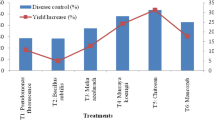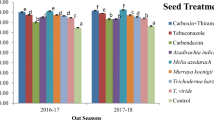Abstract
Rhizoctonia solani, the causal agent of banded leaf and sheath blight (BLSB) of maize is one of the most important pathogen in north western India. Its soil borne nature, wide host range and lack of host resistant sources emphasizes the need to develop alternative management practices such as sowing date (experiment I), nitrogen levels (experiment II), plant spacing (experiment III) and sowing method (experiment IV). Experiments were conducted for two consecutive Kharif seasons (2018 and 2019). Disease severity, area under disease progressive curve (AUDPC) and relative AUDPC (rAUDPC) were found greatest in crops sown on 30th June and least in crop sown on 30th May. Maximum disease severity and lower grain yield were obtained at higher doses of nitrogen (150 kg ha−1). Mean disease severity, AUDPC and r-AUDPC were lower in the ridge sown than flat sown crop. Mean grain yield and 1000 grain weight were found significantly higher in the crop sown on ridges compared to flat sown crop. Closer spacing (60 cm × 15 cm) of plant further enhanced the disease severity thus, reducing the grain yield. Total eight weeds were artificially inoculated with R. solani under in vitro condition. Out of eight weeds tested, disease symptoms were observed on five weeds viz; Acrachne racemosa, Dactyloctenium aegyptium, Echinochloa colonum, Eleusine indica and Cyperus rotandus which were further selected to study the spatial progression of disease in field during Kharif 2019 and 2020. Maximum disease incidence (42.7%) and severity (35.7%) was found in E. colonum infested plot, followed by C. rotundus infested plot. Hence, timely ridge sown weed free crop (particulary from E. colonum and C. rotandus) with recommended nitrogen and spacing is the most appropriate approach to manage banded leaf and sheath blight of maize during Kharif season.






Similar content being viewed by others
Data availability
The data generated and/or analyzed during the present study are attached as supporting information and can also be obtained from the corresponding author on request.
References
Adhikari S, Joshi A, Kumar A, Singh NK, Singh RP (2022) Response of teosinte derived maize lines towards banded leaf and sheath blight (BLSB) disease caused by Rhizoctonia solani. Indian Phytopathology 75:1021–1030
Asif N (2013) Threatening Diseases; banded leaf and sheath blight of maize. Ph.D Thesis. Kisan PG College, Bahraich (U.P), India. p, 256
Bertus LS (1927) Year Book. Department of Agriculture, Ceylon. pp, 44–46
Gao J, Chen Z, Luo M, Peng H, Lin HJ, Qin C, Yuan GS, Shen YO, Ding HP, Zhao MJ, Pan GT, Zhang ZM (2014) Genome expression profile analysis of the maize sheath in response to inoculation to Rhizoctonia solani. Molecular Biology Reports 41:2471–2483
Gazala P, Kuchanur PH, Zaidi PH, Arunkumar B, Patil A, Vinayan KSM (2019) Evaluation of tropical maize hybrids for seed yield and its related traits under heat stress environment (Zea mays L.). Journal of Pharmacognosy and Phytochemistry 8:1840–1845
Gul S, Khan MH, Khanday BA, Nabi S (2015) Effect of sowing methods and NPK levels on growth and yield of rainfed maize (Zea mays L.). Scientifica 1–6. https://doi.org/10.1155/2015/198575
Gupta V, Kroker S, Davoren B, McBeathb T, McKay A, Keller K, Llewellyn R, Roget D (2012) Summer weed control benefits Rhizoctonia disease management in cereal crops. www.grdc.com.au
Hooda KS, Bagaria PK, Khokhar M, Kaur H, Rakshit S (2018) Mass screening techniques for resistance to maize diseases. ICAR- Indian Institute of Maize Research, PAU, Campus, Ludhiana. p, 93
Hooda KS, Khokha MK, Parmar H, Gogoi R, Joshi D, Sharma SS, Yadav OP (2017) Banded leaf and sheath blight of maize: historical perspectives, current status and future directions. Proceedings of the National Academy of Sciences, India Section B: Biological Sciences 87:1041–1052
Huber DM, Thompson IA (2007) Nitrogen and plant disease. In: Datnoff LE, Elmer WH, Huber DM (eds) Mineral nutrition and plant disease. APS Press, pp 31–44
Izhar T, Chakraborty M (2013) Genetic analysis of banded leaf and sheath blight resistance (Rhizoctonia solani) in maize. Journal of Pharmacognosy and Phytochemistry 1:1–5
Kaur H, Ahmadi K, Kumar S, Kumar M (2022) Associations between charcoal rot disease and grain yield in different sowing dates in spring maize (Zea mays L.). Indian Phytopathology 75:741–747
Kaur H, Kumar S, Hooda KS, Gogoi R, Bagaria P, Singh RP, Mehra R, Kumar A (2020) Leaf stripping: an alternative strategy to manage banded leaf and sheath blight of maize. Indian Phytopathology 73:203–211
Kaur H, Singh S (2014) Effect of different weed flora on the development of banded leaf and sheath blight on kharif maize. National Symposium on “Crop Improvement for Inclusive Sustainable Development, p 287
Kaur T (2002) Studies on the irrigation requirement in relation to method of planting of maize (Zea mays L.). M.Sc. Thesis, Punjab Agricultural University, Ludhiana
Kumar A, Hunjan MS, Singh PP, Kaur H (2015) Status of bacterial stalk rot of maize in Punjab. Plant Diseases Research 30:97–99
Kumar PM, Reddy PN, Reddy RR, Babu S (2017) Effect of spacing and dosage of nitrogen on turcicum leaf blight disease incidence on maize. International Journal of Pure and Applied Biosciences 5:1273–1276
Kumar S, Kaur H (2020) Prevalence of banded leaf and sheath blight of maize in Punjab and its management with fungicides. Agricultural Research Journal 57:738–744
Kumar S, Kaur H, Hunjan MS (2021) Genetic diversity and virulence spectrum of Rhizoctonia solani, the incitant of banded leaf and sheath blight of maize. Journal of Phytopathology 169:486–499
Mahuku G (2010) Maize pathology in Asia: opportunities and challenges for breeding disease-resistant maize. In: Proceedings of the Asian regional maize workshop, vol 10. Makassar (Indonasia), pp 361–366
Mareeswari P, Seetharaman K, Mohan L, Kamalakannan A, Rajinomala N, Karuppiah R, Chitra K (2004) Host range of Rhizoctonia solani inciting rice sheath blight disease. Indian Phytopathology 57:349
Mehra R, Kamboj MC, Mehla JC, Lal M, Chand M (2012) Status of maize diseases and their management in Haryana. Proceeding on “National Seminar on Sustainable Agriculture and Food Security: Challenges in Changing Climate”, p 217
Munkvold GP, White DG (2016) Compedium of corn diseases, 4th edn. American Phytopathological society, USA, pp 1–6
Nishat A (2009) Prevalence of maize diseases in Bahraich (U.P). Annals of Plant Protection Sciences 17:512–513
Pal R, Mandal D, Biswas MK (2016) Effect of different sowing dates on the development and spread of sheath blight disease in rice. Journal of Crop Weed 12:116–119
Panella L (1995) Artificial epiphytotic of Rhizoctonia root rot and Cercospora leaf spot: consistency of disease intensity over time. Proceedings of the 58th Congress of the International Institute for Beet Research pp, 335–36
Parveen S, Bhuiwan MR, Khan MAI, Ali MA (2018) Effect of planting time on sheath blight disease of rice in Bangladesh. Bangladesh Rice Journal 22:55–62
Pascual CB, Raymundo AD (1989) Evaluation of resistance and yield loss in sorghum due to Rhizoctonia sheath blight. Philippine Journal of Crop Science 14:133–135
Payak MM, Renfro BL (1966) Diseases of maize new to India. Indian Phytopathology Society Bulletin 3:14–18
Payak MM, Sharma RC (1980) An inventory and bibliography for maize diseases in India. Division of Mycology and Plant Pathology, IARI, New Delhi. p, 67
POP (2017) Package of Practices for Kharif Crops. Punjab Agricultural University, Ludhiana, pp 20–25
Prasad D, Singh R, Singh A (2010) Management of sheath blight of rice with integrated nutrients. Indian Phytopathology 63:11–15
Roget DK, Neate SM, Rovira AD (1996) Effect of sowing point design and tillage practice on the incidence of Rhizoctonia root rot, take-all and cereal cyst nematode in wheat and barley. Australian Journal of Experimental Agriculture 36:683–693
Saveinai R, Baiswar P, Kumar R, Rajesh T, Behere GT (2017) Pathogenicity of Rhizoctonia solani AG 1-IA on major weeds prevalent in rice and maize ecosystem in Meghalaya. Indian Phytopathology 70:91–97
Saxena SC (1997) Banded leaf and sheath blight of maize. In: Agnihotri VP, Sarbhoy AK, Singh DV (eds) Management of threatening plant diseases of national importance. Malhotra Publishing House, New Delhi, pp 31–50
Sharma BC, Singh RP (2019) Effect of planting methods and management practices on maydis leaf blight of maize. International of Journal Pure and Applied Biosciences 7:147–153
Sharma G, Saxena SC (2002) Integrated management of banded leaf and sheath blight of maize (Zea mays L.) caused by Rhizoctonia solani (Kuhn). Advances in Plant Science 15:107–113
Sharma RC, Vasal SK, Gonzalez F, Batsa BK, Singh NN (2002) Redressal of banded leaf and sheath blight of maize through breeding chemical and biological agents. In: Srinivas G, Zaidi P H, Prasanna B M, Gonzalez F, Lesnik K (eds.) Proc 8th Asian Regional Maize Workshop: New Technologies for the New Millenium. pp, 391–397
Shurtleff MC (1980) Compendium of corn disease, 2nd edn. American Phytopathological Society, p 105
Singh M (2011) Growth, yield and water productivity of spring planted hybrid maize (Zea mays L.) cultivars as influenced by method and time of planting and irrigation regimes. Ph. D. Thesis, Punjab Agricultural University, Ludhiana
Trivedi A, Rathore RS (2006) New grass hosts for banded leaf and sheath blight of Maize. Indian Phytopathology 59:253–254
Wilcoxson RD, Srovmand B, Atif AH (1975) Evaluation of wheat cultivars for ability to retard development of stem rust. Annals of Applied Biology 80:275–281
Willocquet L, Fernandez L, Savary S (2000) Effect of various crop establishment methods practiced by Asian farmers on epidemics of rice sheath blight caused by Rhizoctonia solani. Plant Pathology 49:346–354
Yang GH, Conner RL, Chen YY, Chen JY, Wang YG (2008) Frequency and pathogenicity distribution of Rhizoctonia spp. causing sheath blight on rice and banded leaf disease on maize in Yunnan. China Journal of Plant Pathology 90:387–392
Acknowledgements
We acknowledge Punjab Agricultural University, Ludhiana for providing seed material, the infrastructure and other facilities for conducting experiments.
Funding
The research was fully supported by Indian Council of Agricultural Research, New Delhi—Extramural grant ‘Characterization, population dynamics and management of Rhizoctonia in different cropping systems’ to HK and MSH.
Author information
Authors and Affiliations
Contributions
HK, MSH and TK designed the research work. HK and SK conducted the experiments. SK collected the data and did statistical analysis. HK, SK, MSH and TK prepared the manuscript.
Corresponding authors
Ethics declarations
Conflict of interest
The authors declare that they do not have any conflict of interest.
Additional information
Publisher's note
Springer Nature remains neutral with regard to jurisdictional claims in published maps and institutional affiliations.
Rights and permissions
Springer Nature or its licensor (e.g. a society or other partner) holds exclusive rights to this article under a publishing agreement with the author(s) or other rightsholder(s); author self-archiving of the accepted manuscript version of this article is solely governed by the terms of such publishing agreement and applicable law.
About this article
Cite this article
Kumar, S., Kaur, H., Hunjan, M.S. et al. Alternative management practices for the control of banded leaf and sheath blight incited by Rhizoctonia solani f.sp. sasakii (Kuhn) Exner in maize in North Western India. Trop. plant pathol. 48, 604–613 (2023). https://doi.org/10.1007/s40858-023-00604-6
Received:
Accepted:
Published:
Issue Date:
DOI: https://doi.org/10.1007/s40858-023-00604-6




